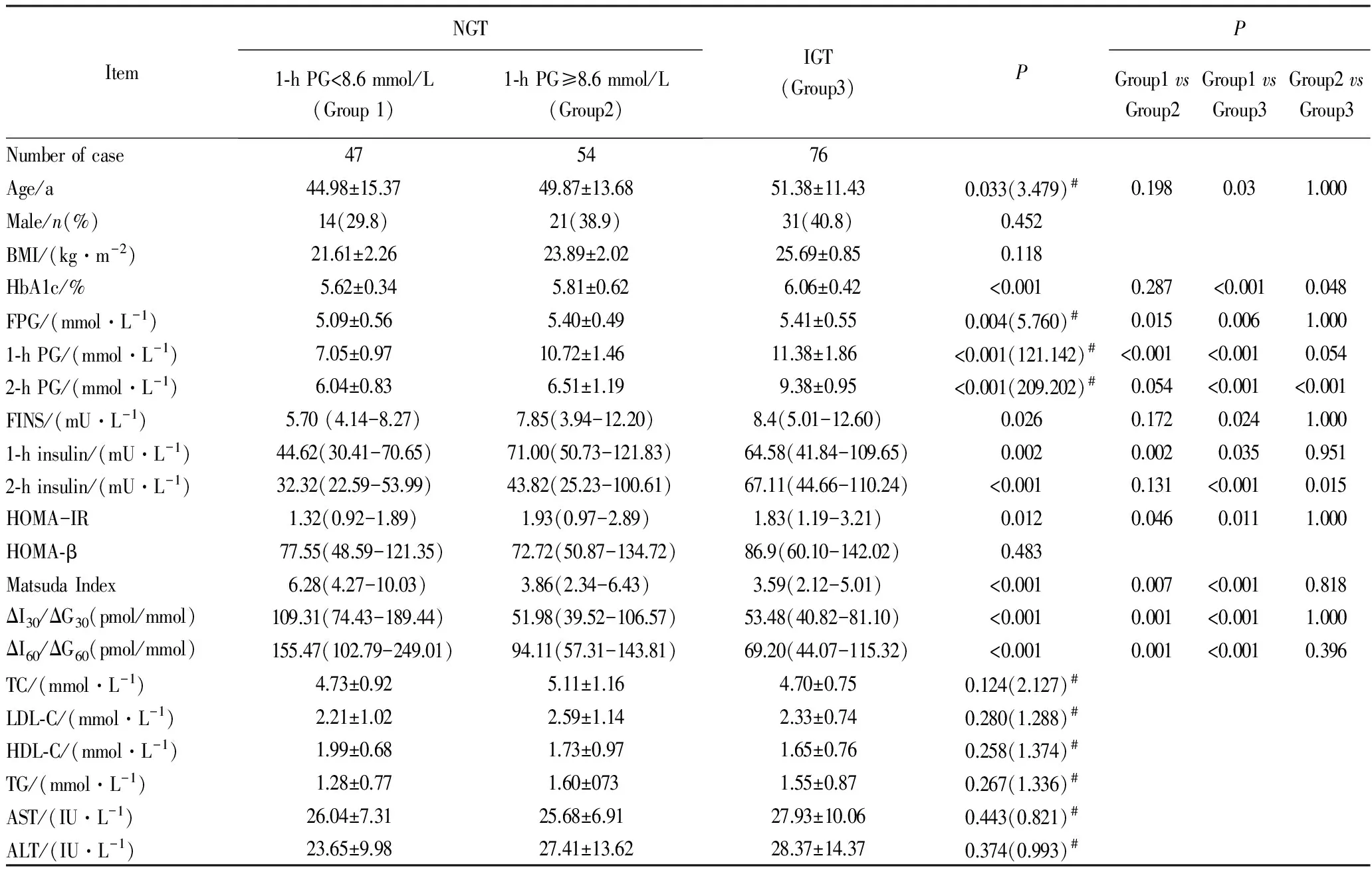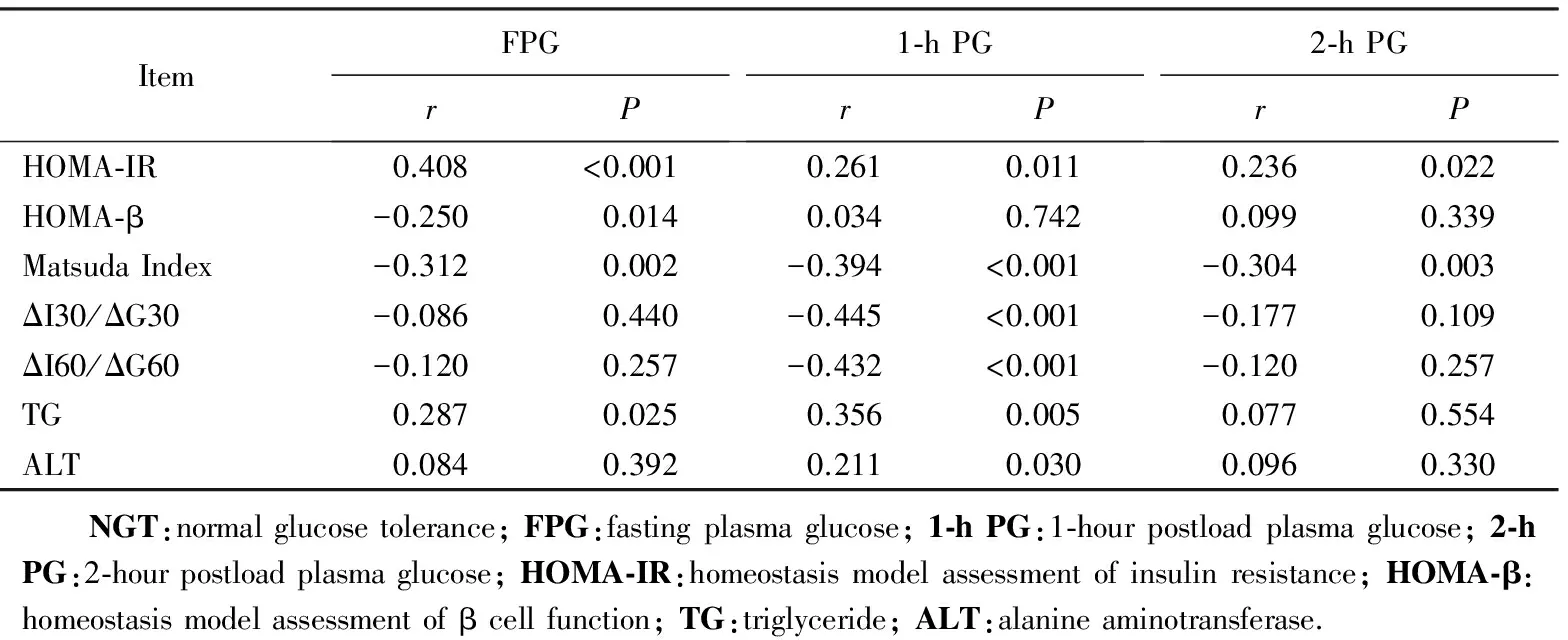糖耐量正常人群OGTT 1 h血糖与胰岛素敏感性和胰岛β细胞功能的关系
朱莉莉 陈 哲 刘 鑫 于 娜 潘清蓉
(首都医科大学附属北京朝阳医院内分泌科,北京 100020)
· 临床研究 ·
糖耐量正常人群OGTT 1 h血糖与胰岛素敏感性和胰岛β细胞功能的关系
朱莉莉 陈 哲 刘 鑫 于 娜 潘清蓉*
(首都医科大学附属北京朝阳医院内分泌科,北京 100020)
目的 评价糖耐量正常(normal glucose tolerance, NGT)人群口服葡萄糖耐量试验(oral glucose tolerance test, OGTT)1 h血糖与胰岛素敏感性和胰岛β细胞功能的关系。方法 收集101例NGT和76例糖耐量异常(impaired glucose tolerance, IGT)病人的临床资料;测定OGTT各时间点的血浆葡萄糖和胰岛素浓度;比较NGT 1 h血糖 (1 hour postload plasma glucose, 1-h PG)<8.6 mmol/L组、NGT 1-h PG ≥8.6 mmol/L组和IGT组的胰岛素敏感性和胰岛β细胞功能,分析OGTT 1-h PG与胰岛素敏感性和胰岛β细胞功能的关系。结果 NGT 1-h PG≥8.6 mmol/L组的空腹血糖、1-h PG、1-h 胰岛素及胰岛素敏感指数(homeostasis model assessment of insulin resistance,HOMA-IR)均显著高于NGT 1-h PG<8.6 mmol/L组;NGT 1-h PG≥8.6 mmol/L组的Matsuda指数、胰岛素分泌指数(ΔI30/ΔG30和ΔI60/ΔG60)均显著低于NGT 1-h PG<8.6 mmol/L组(P均<0.05)。但NGT 1-h PG≥8.6 mmol/L组的空腹血糖、空腹胰岛素、1-h PG、1-h 胰岛素、HOMA-IR、Matsuda指数、ΔI30/ΔG30和ΔI60/ΔG60与IGT组比较,差异无统计学意义(P均>0.05)。多元线性回归分析显示1-h PG与ΔI30/ΔG30、Matsuda 指数呈线性负相关。结论 在NGT人群中,OGTT 1-h PG≥8.6 mmol/L人群胰岛素敏感性和胰岛β细胞功能低于1-h PG<8.6 mmol/L组, 1-h PG与胰岛素敏感性和胰岛β细胞功能相关。提示在NGT人群中,1-h PG浓度可作为评价胰岛素敏感性和胰岛β细胞功能的简易指标。
OGTT 1-h 血糖; 胰岛素敏感性; 胰岛β细胞功能
近年来,中国的糖尿病发病率呈明显上升,2010年中国成人糖尿病的患病率达11.6%,糖尿病前期也高达50.1%[1]。空腹血糖受损(impaired fasting glucose, IFG)和糖耐量异常(impaired glucose tolerance, IGT)被称为糖尿病前期。约70%的糖尿病前期病人最终可发展为2型糖尿病,他们是糖尿病预防的重点人群[2]。但是,仍有约40%的糖尿病病人由糖耐量正常(normal glucose tolerance, NGT)的人群发展而来[3]。因此,在NGT人群中筛选出糖尿病的高危人群至关重要。
多项国外研究[4-7]表明,NGT人群中,糖耐量试验(oral glucose tolerance test,OGTT)1 h血糖 (1 hour postload plasma glucose, 1-h PG) 较空腹血糖和OGTT 2 h血糖(2 hour postload plasma glucose, 2-h PG)对将来2型糖尿病发生的预测价值更大。在NGT 人群中,1-h PG≥8.6 mmol/L人群胰岛素敏感性和胰岛β细胞功能显著低于1-h PG<8.6 mmol/L人群,且与IGT人群相似,1-h PG与胰岛素敏感性和胰岛β细胞功能显著相关[8-10]。但是,在中国人群中1-h PG 的相关研究较少。本研究旨在阐明中国NGT人群OGTT 1-h PG浓度与胰岛素敏感性和胰岛β细胞功能的关系,为筛查NGT人群中的糖尿病高危病人提供依据。
1 对象和方法
1.1 研究对象
选取2015年6月至2016年6月就诊于首都医科大学附属北京朝阳医院内分泌科门诊且经过OGTT证实的NGT人群和IGT病人。排除标准:妊娠、糖尿病、甲状腺功能异常、严重肝肾疾患、恶性肿瘤、精神疾病、有糖皮质激素服用史。共177例病人入选,平均年龄(49±13)岁,其中男性66例,女性111例。参照1999年世界卫生组织(World Health Organization,WHO)糖尿病诊断标准,空腹血糖(fasting plasma glucose, FPG)<6.1 mmol/L且OGTT 2-h PG<7.8 mmol/L定义为NGT; FPG<6.1 mmol/L 且OGTT 2-h PG 7.8~11.1 mmol/L定义为IGT组(n=76);NGT且OGTT 1-h PG<8.6 mmol/L定义为NGT 1-h PG低组(n=47);NGT且OGTT 1-h PG≥8.6 mmol/L定义为NGT 1-h PG高组(n=54)。本试验已通过医院伦理委员会批准,在资料收集前获得所有入选对象的知情同意。
1.2 生物化学指标检测
所有研究对象隔夜空腹8~12 h,测量身高、体质量,抽静脉血。口服75g标准无水葡萄糖,在服糖后30、60、120、180 min分别抽血检测血浆血糖和胰岛素浓度。全自动生化分析仪测定空腹血糖、总胆固醇(total cholesterol,TC)、三酰甘油(triglyceride, TG)、高密度脂蛋白胆固醇(high density lipoprotein-cholesterol, HDL-C)、低密度脂蛋白胆固醇(low density lipoprotein-cholesterol, LDL-C)、同型半胱氨酸、丙氨酸氨基转移酶(alanine aminotransferase,ALT)、门冬氨酸氨基转移酶(aspartate aminotransferase,AST)、肌酐。糖化血红蛋白(glycosylated hemoglobin, HbA1c)测定使用高压液相法,空腹胰岛素(fasting insulin,FINS)测定使用化学发光法。
1.3 参数计算
体质量指数(body mass index,BMI)=体质量(kg)/身高(m)2;稳态模型评估的胰岛β细胞功能(homeostasis model assessment of β cell function, HOMA-β)和胰岛素抵抗指数(homeostasis model assessment of insulin resistance,HOMA-IR): HOMA-β=20×FINS/(FPG-3.5),HOMA-IR=FINS×FPG/22.5; 胰岛素分泌指数(ΔI/ΔG):ΔI30/ΔG30(下标为时间)=(INS30-FINS)/(PG30-FPG)、ΔI60/ΔG60(下标为时间)=(INS60-FINS)/(PG60-FPG)[10];反映全身胰岛素敏感性的Matsuda指数=10 000/[FPG(mg/dL)×FINS(mU/L)×OGTT平均血糖(mg/dL)×OGTT平均胰岛素(mU/L)]1/2[11]。
1.4 统计学方法
2 结果
2.1 3组人群生化指标、胰岛素敏感性和胰岛β细胞功能比较
1-h PG≥8.6 mmol/L者在NGT人群中占53.5%,而在IGT 病人中占90.8%。3组人群的性别、BMI、HOMA-β等差异无统计学意义(P均>0.05)。NGT 1-h PG≥8.6 mmol/L组人群的空腹血糖、1-h PG、1-h 胰岛素及HOMA-IR均显著高于NGT 1-h PG<8.6 mmol/L组;NGT 1-h PG≥8.6 mmol/L组人群的Matsuda指数、ΔI30/ΔG30和ΔI60/ΔG60均显著低于NGT 1-h PG<8.6 mmol/L组(P均<0.05)。 IGT组的Matsuda指数、ΔI30/ΔG30和ΔI60/ΔG60均显著低于NGT 1-h PG<8.6 mmol/L组(P均<0.05),但NGT 1-h PG≥8.6 mmol/L组的FPG、FINS、1-h PG、1-h 胰岛素、HOMA-IR、Matsuda指数、ΔI30/ΔG30和ΔI60/ΔG60与IGT组比较,差异无统计学意义(P均>0.05),详见表1。

表1 NGT 1-h PG<8.6 mmol/L组、NGT 1-h PG ≥8.6 mmol/L组和IGT组的生物化学指标、胰岛素敏感性和胰岛β细胞功能比较
Data are presented as the means±SD, median (interquartile range) orn(%). NGT:normal glucose tolerance; IGT:impaired glucose tolerance; BMI:body mass index; HbA1c:glycosylated hemoglobin; FPG:fasting plasma glucose; 1-h PG:1-hour postload plasma glucose; 2-h PG:2-hour postload plasma glucose; FINS:fasting insulin; HOMA-IR:homeostasis model assessment of insulin resistance; HOMA-β;homeostasis model assessment of β cell function; TC:total cholesterol; LDL-C:low density lipoprotein-cholesterol; HDL-C:high density lipoprotein-cholesterol; TG:triglyceride; AST:aspartate aminotransferase; ALT:alanine aminotransferase;#Fvalue measured by ANOVA.
2.2 NGT人群FPG、1-h PG、2-h PG与生物化学指标、胰岛β细胞功能和胰岛素敏感性的相关性
在NGT人群,1-h PG与TG、ALT、HOMA-IR、ΔI30/ΔG30、ΔI60/ΔG60、Matsuda 指数均相关(P均<0.05);空腹血糖与HOMA-IR、HOMA-β、Matsuda指数、TG相关(P均<0.05);2-h PG与HOMA-IR、Matsuda指数相关(P均<0.05),详见表2。运用多元线性回归分析,发现1-h PG与ΔI30/ΔG30和Matsuda指数呈线性负相关(R2=0.588,P<0.000 1),但与其他反映胰岛素敏感性和胰岛β细胞功能的指标无相关性,详见表3。
3 讨论

表2 NGT人群空腹血糖、1-h PG、2-h PG与生化指标、胰岛β细胞功能和胰岛素敏感性的相关性

表3 1-h PG与胰岛素敏感性和胰岛β细胞功能的相关性
本研究根据OGTT 1-h PG浓度将NGT分为NGT 1-h PG低(1-h PG<8.6 mmol/L)组和NGT 1-h PG高(1-h PG ≥8.6 mmol/L)组。研究显示NGT 1-h PG高组HOMA-IR显著高于NGT 1-h PG低组,而代表胰岛素早中期分泌的指数ΔI30/ΔG30、ΔI60/ΔG60及代表全身胰岛素敏感性的Matsuda指数显著低于NGT 1-h PG低组。提示NGT人群中1-h PG≥8.6 mmol/L组的胰岛素敏感性和胰岛β细胞功能较1-h PG<8.6 mmol/L组差,但与IGT组比较,差异无统计学意义。进一步行多元线性回归显示,1-h PG与ΔI30/ΔG30、Matsuda指数相关,与年龄、性别、BMI、肝功能等无关。提示在NGT人群中,1-h PG可作为评价胰岛素敏感性和胰岛β细胞功能的简易指标。
有研究[5]表明,在非糖尿病的人群中,基线1-h PG较空腹血糖、OGTT半小时血糖和2 h血糖而言,对将来2型糖尿病发生的预测价值更大。Malmö Prevention Project(MPP)研究[7]结果亦提示基线1-h PG是2型糖尿病发生的良好预测指标,并显著优于HbA1c。Manco等[12]发现NGT 1-h PG≥8.95 mmol/L的人群胰岛素敏感性和胰岛β细胞功能显著低于NGT 1-h PG<8.95 mmol/L的人群。Abdul-Ghani等[5]提出使用8.6 mmol/L作为1-h PG的界值,发现NGT人群将来发展为糖尿病的概率为2.3%,但NGT 1-h PG≥8.6 mmol/L的人群发展为糖尿病的概率显著升高,为8.5%。利用血糖钳夹试验及静脉糖耐量试验进一步揭示NGT 1-h PG≥8.6 mmol/L的人群胰岛素敏感性和胰岛β细胞功能显著低于NGT 1-h PG<8.6 mmol/L的人群[8]。胰岛素敏感性和胰岛β细胞功能降低是糖尿病发生的主要病理生理特点,也是预测将来糖尿病发生的重要指标[6]。本研究显示NGT 1-h PG与胰岛素敏感性和胰岛素释放指数的相关性与之前国外的研究[4-7]相符,提示应重视我国NGT 1-h PG≥8.6 mmol/L人群的糖尿病预防。
Shimodaira 等[13]的研究表明NGT 1-h PG≥8.6 mmol/L的人群血TG浓度高于NGT 1-h PG<8.6 mmol/L人群,HDL-C浓度显著低于NGT 1-h PG<8.6 mmol/L人群;1-h PG 还与HDL-C 浓度 和TG/HDL-C值显著相关。另一项研究[14]表明,NGT 1-h PG≥8.6 mmol/L的人群血ALT浓度较高,并有较高的发生非酒精性脂肪肝的风险。本研究未发现上述关系,这可能与样本量相对较小有关。
本研究显示IGT 病人中90.8% 1-h PG≥8.6 mmol/L,这与国外的研究[4]符合;但是,NGT人群中53.5% 1-h PG≥8.6 mmol/L,这一比例高于之前的研究[8-9, 15]。Bianchi等[8]在GENFIEV (Genetics, Physiopathology, and Evolution of Type 2 diabetes) 研究中发现NGT人群中1-h PG≥8.6 mmol/L占36%,San Antonio Heart研究[15]中这一比率是16.7%,另一项意大利的研究[9]报道比率是28%。这可能是因为本研究纳入的研究对象来自内分泌门诊,病人曾被发现血糖、血压或血脂偏高或有糖尿病家族史来就诊,引起本研究NGT人群中1-h PG≥8.6 mmol/L的比例稍高。这也提示使用1-h PG可以筛选出NGT中糖尿病的高危人群。
本研究存在一些局限性。首先,入选病人均来自本院门诊,因此,NGT人群中1-h PG≥8.6 mmol/L的比例偏高,存在选择偏倚;其次,样本量相对较小,仍需大样本的固定人群的OGTT筛查研究去进一步证实糖负荷后1-h PG与胰岛β细胞功能和胰岛素敏感性的关系。
综上所述,本研究表明NGT人群中OGTT 1-h PG≥8.6 mmol/L组胰岛素敏感性和胰岛β细胞功能较1-h PG<8.6 mmol/L组均低,但与IGT组比较,差异无统计学意义。1-h PG与胰岛素敏感指数和胰岛素分泌指数均有显著的相关性。提示在NGT人群中,1-h PG浓度可作为评价胰岛素敏感性和胰岛β细胞功能的简易指标,应重视NGT 1-h PG≥8.6 mmol/L人群的糖尿病预防。
[1] Xu Y, Wang L, He J, et al. Prevalence and control of diabetes in Chinese adults[J]. JAMA, 2013,310(9):948-959.
[2] Tabak A G, Herder C, Rathmann W, et al. Prediabetes: a high-risk state for diabetes development[J]. Lancet, 2012,379(9833):2279-2290.
[3] Aekplakorn W, Bunnag P, Woodward M, et al. A risk score for predicting incident diabetes in the thai population[J]. Diabetes Care, 2006,29(8):1872-1877.
[4] Abdul-Ghani M A, DeFronzo R A. Plasma glucose concentration and prediction of future risk of type 2 diabetes[J]. Diabetes Care, 2009,32 Suppl 2:S194-S198.
[5] Abdul-Ghani M A, Lyssenko V, Tuomi T, et al. Fasting versus postload plasma glucose concentration and the risk for future type 2 diabetes: results from the botnia study[J]. Diabetes Care, 2009,32(2):281-286.
[6] Abdul-Ghani M A, Williams K, DeFronzo R A, et al. What is the best predictor of future type 2 diabetes?[J]. Diabetes Care, 2007,30(6):1544-1548.
[7] Alyass A, Almgren P, Akerlund M, et al. Modelling of OGTT curve identifies 1 h plasma glucose level as a strong predictor of incident type 2 diabetes: results from two prospective cohorts[J]. Diabetologia, 2015,58(1):87-97.
[8] Bianchi C, Miccoli R, Trombetta M, et al. Elevated 1-hour postload plasma glucose levels identify subjects with normal glucose tolerance but impaired beta-cell function, insulin resistance, and worse cardiovascular risk profile: the GENFIEV study[J]. J Clin Endocrinol Metab, 2013,98(5):2100-2105.
[9] Marini M A, Succurro E, Frontoni S, et al. Insulin sensitivity, beta-cell function, and incretin effect in individuals with elevated 1-hour postload plasma glucose levels[J]. Diabetes Care, 2012,35(4):868-872.
[10]Oh T J, Min S H, Ahn C H, et al. Normal glucose tolerance with a high 1-hour postload plasma glucose level exhibits decreased beta-cell function similar to impaired glucose tolerance[J]. Diabetes Metab J, 2015,39(2):147-153.
[11]Matsuda M, DeFronzo R A. Insulin sensitivity indices obtained from oral glucose tolerance testing: comparison with the euglycemic insulin clamp[J]. Diabetes Care, 1999,22(9):1462-1470.
[12]Manco M, Panunzi S, Macfarlane D P, et al. One-hour plasma glucose identifies insulin resistance and beta-cell dysfunction in individuals with normal glucose tolerance: cross-sectional data from the Relationship between Insulin Sensitivity and Cardiovascular Risk (RISC) study[J]. Diabetes Care, 2010,33(9):2090-2097.
[13]Shimodaira M, Niwa T, Nakajima K, et al. Correlation between serum lipids and 1-hour postload plasma glucose levels in normoglycemic individuals[J]. J Clin Lipidol, 2014,8(2):217-222.
[14]Sesti G, Hribal M L, Fiorentino T V, et al. Elevated 1 h postload plasma glucose levels identify adults with normal glucose tolerance but increased risk of non-alcoholic fatty liver disease[J]. BMJ Open Diabetes Res Care, 2014,2(1):e000016.
[15]Abdul-Ghani M A, Abdul-Ghani T, Ali N, et al. One-hour plasma glucose concentration and the metabolic syndrome identify subjects at high risk for future type 2 diabetes[J]. Diabetes Care, 2008,31(8):1650-1655.
编辑 陈瑞芳
Relationships between OGTT 1-h plasma glucose levels and insulin sensitivity and pancreatic β cell function in subjects with normal glucose tolerance
Zhu Lili, Chen Zhe, Liu Xin, Yu Na, Pan Qingrong*
(DepartmentofEndocrinology,BeijingChaoyangHospital,CapitalMedicalUniversity,Beijing100020,China)
Objective To evaluate the relationships between oral glucose tolerance test (OGTT)1h plasma glucose levels (1-h PG) and insulin sensitivity and pancreatic β cell function. Methods A total of 177 individuals without diabetes mellitus from Beijing Chaoyang Hospital were enrolled in the study from June 2015 to June 2016, all of them undertook a 75 g OGTT, and then we examined the correlation between 1-h PG and insulin sensitivity and pancreatic β cell function. Results In the normal glucose tolerance (NGT) 1-h≥ 8.6 mmol/L group, fasting plasma glucose,1-h PG,1-h insulin and steady-state homeostasis model assessment of insulin resistance (HOMA-IR) were significantly higher than that in the NGT 1-h<8.6 mmol/L group, but dynamic insulin sensitivity index (Matsuda index) and insulin secretion index (ΔI30/ΔG30and ΔI60/ΔG60) were significantly lower than that in the NGT 1 h<8.6 mmol/L group. There were no differences in fasting plasma glucose, 1-h PG, 1-h insulin, HOMA-IR, Matsuda index, ΔI30/ΔG30and ΔI60/ΔG60between the NGT 1-h≥ 8.6 mmol/L group and IGT group. It showed that 1-h PG negatively correlated with ΔI30/ΔG30and Matsuda index by using multivariable linear regression model.Conclusion Among individuals with NGT, those with 1-hour OGTT glucose ≥8.6 mmol/L show lower insulin sensitivity and impaired β cell function. OGTT 1-h PG is associated with insulin sensitivity and β cell function.
OGTT 1-h PG; insulin sensitivity; insulin β cell function
国家自然科学基金(81100587),北京市医院管理局“青苗”计划(QML20160304),首都医科大学本科生科研创新项目(73000737)。 This study was supported by National Natural Science Foundation of China(81100587), Qingmiao Plan of Beijing Municipal Administration of Hospitals(QML20160304), Undergraduate Scientific Research and Innovation Program of Capital Medical University(73000737).
时间:2017-07-16 17∶23 网络出版地址:http://kns.cnki.net/kcms/detail/11.3662.r.20170716.1723.024.html
10.3969/j.issn.1006-7795.2017.04.020]
R589.1
2017-03-20)
*Corresponding author, E-mail:panqingrongcn@163.com

